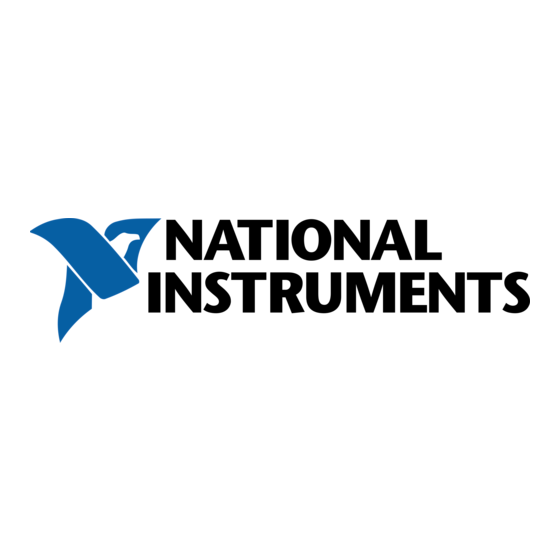

National Instruments NI-9237 Getting Started
Hide thumbs
Also See for NI-9237:
- Operating instructions manual (37 pages) ,
- Getting started manual (21 pages)
Advertisement
Quick Links
Advertisement

Summary of Contents for National Instruments NI-9237
- Page 1 NI-9237 Getting Started 2025-04-09...
- Page 2 NI-9237 Getting Started ........
- Page 3 The NI-9237 is isolated from earth ground. However, the individual channels are not isolated from each other. The EX+, EX-, and T- signals are common among all channels. You can connect the NI-9237 to a device that is biased at any voltage within the NI-9237 rejection range of earth ground.
- Page 4 The resistance in the wires that connect the excitation voltage to the bridge causes a voltage drop, which is a source of gain error. The NI-9237 includes remote sensing to compensate for this gain error. Connect remote sense wires to the points where the excitation voltage wires connect to the bridge circuit.
- Page 5 Excitation Voltages Excitation Voltages You can program the NI-9237 to supply 2.5 V, 3.3 V, 5 V, or 10 V of excitation voltage. The maximum excitation power for internal excitation is 150 mW. Note Unless you supply external excitation voltage, NI recommends that you set the excitation voltage to a value that keeps the total power below 150 mW.
- Page 6 External Excitation External Excitation You can connect an external excitation voltage source to the NI-9237 if you need an excitation voltage that causes more than 150 mW to dissipate across all the bridges. Figure 3. Connecting an External Excitation Voltage Source to the NI-9237...
- Page 7 Ch 3 EX– EX– Caution Do not use RJ-45 cables with the NI-9237 with RJ-50. RJ-45 cables damage the RJ-50 connector, permanently disabling the shunt calibration, regardless of which connector you use. Table 1. NI-9237 with RJ-50 Signal Descriptions Signal Name...
- Page 8 Negative analog input signal connection Positive remote sensing connection Negative remote sensing connection Positive sensor excitation connection Negative sensor excitation connection TEDS data connection TEDS return connection Shunt calibration connection Connecting a Full Bridge You can connect a full bridge to the NI-9237. ni.com...
- Page 9 RS- /SC- NI-9237 with DSUB NI-9237 with RJ50 You also can connect floating signals to the NI-9237. If you connect floating signals to the NI-9237, NI recommends connecting the EX- signal to the earth ground or shield for better noise rejection.
- Page 10 RS- /SC- NI-9237 with DSUB NI-9237 with RJ50 You also can use a quarter bridge with the NI-9237 with RJ-50 if you use the NI 9944 or NI 9945 Quarter Bridge Completion Accessory. Connecting TEDS Sensors You can connect TEDs sensors to the NI-9237.
- Page 11 The digital filters of the NI-9237 adjust the frequency range of the passband to match the data rate. Therefore, the amount of gain or attenuation at a given frequency depends on the data rate.
- Page 12 12.8 MHz, the result is data rates of 50 kS/s, 25 kS/s, 16.667 kS/s, and so on down to 1.613 kS/s depending on the value of n. When using an external timebase with a frequency other than 12.8 MHz, the NI-9237 has a different set of data rates.
- Page 13 NI-9237 Getting Started Operating humidity (IEC 60068-2-30 Test Db) 80 to 100% RH, condensing Related information: • Conformal Coating and NI RIO Products © National Instruments © 2025 National Instruments Corporation.
















Need help?
Do you have a question about the NI-9237 and is the answer not in the manual?
Questions and answers